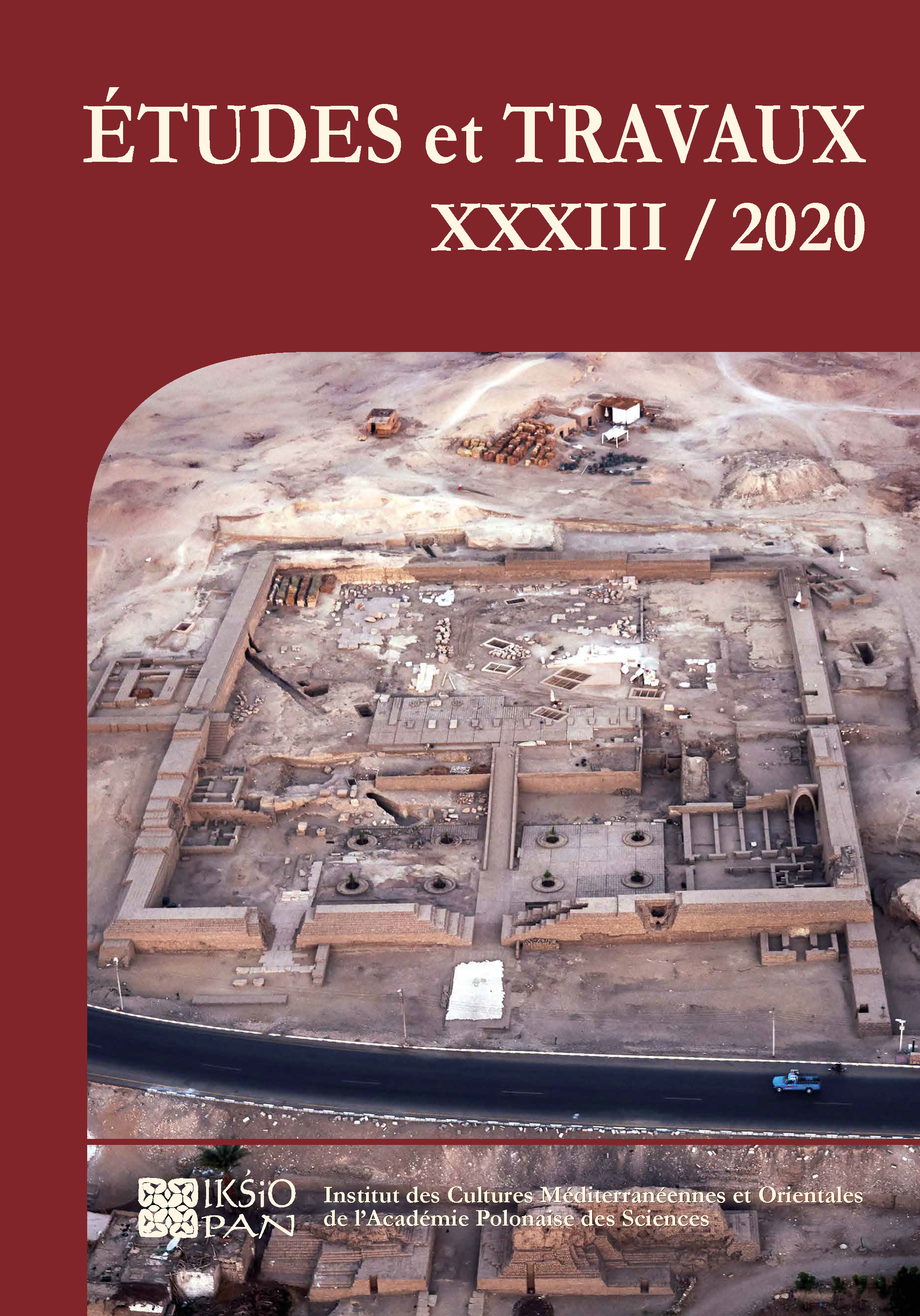Ramesside Inscriptions and Preparatory Sketches in the Western Wall of Portico of Obelisks of Hatshepsut’s Temple at Deir el-Bahari
DOI:
https://doi.org/10.12775/EtudTrav.33.007Słowa kluczowe
New Kingdom Egypt, Portico of Obelisks, Temple of Hatshepsut, dipinti, Deir el-Bahari, Ramesside restorationsAbstrakt
The representations of all the gods on the western wall of the Portico of Obelisks in Hatshepsut’s temple at Deir el-Bahari were destroyed during the Amarna period and restored under the reign of Ramesses II. In this paper, the inscriptions related to those restorations are commented on, along with a set of dipinti drawn on undecorated blocks below the dado lines. Those dipinti, of varying quality, represent the god Amun. Because of their location and form they were probably ‘restoration guidelines’ for the sculptors re-creating the destroyed images of the god. The paper’s aim is to reconfirm the dating of the restorations in this part of the temple and discuss the possible reasons for the dipinti creation.
Bibliografia
Barwik, M. 2013: Ancient Restorers in the Temple of Hatshepsut at Deir El-Bahari in the Light of Newly Found Graffiti, EtudTrav XXVI/1, 95–101
Barwik, M. 2018: New Dipinti in the Birth Portico of the Hatshepsut Temple at Deir el-Bahari, EtudTrav XXXI, 101–110
Brand, P. 1999a: Secondary Restorations in the Post-Amarna Period, JARCE XXXVI, 113–134
Brand, P. 1999b: Methods Used in Restoring Reliefs Vandalized during the Amarna Period, GöttMisz 170, 37–48
Cruz-Uribe, E. 2008: Graffiti (Figural), [in:] Wendrich, W. (Ed.), UCLA Encyclopedia of Egyptology, Los Angeles, http://digital2.library.ucla.edu/viewItem.do?ark=21198/zz000s7j4s (accessed November 3, 2020)
Ćwiek, A. 2015: Ha in Sheta, PAM XXIV/2, 83–92
Ćwiek, A., Sankiewicz, M. 2008: The Scene of “Going round the Wall” on the North Wall of the Portico of the Birth, PAM XVIII, 290–294
Eaton-Krauss, M. 2002: Restorations and Erasures in the Post-Amarna Period, [in:] Hawass, Z. (Ed.), Egyptology at the Dawn of the Twenty-first Century, Proceedings of the Eighth International Congress of Egyptologists, vol. 2, Cairo, 194–202
Epigraphic Survey 2009: The Epigraphic Survey, Medinet Habu IX: The Eighteenth Dynasty Temple, Part 1: The Inner Sanctuaries, with Translations of Texts, Commentary and Glossary, OIP 136, Chicago 2009
Karkowski, J. 1976: Deir el-Bahari 1972–1973 (travaux égyptologiques), EtudTrav IX, 251–260
Karkowski, J. 1979: The Decoration of the Upper Court Columns – an Egyptological Note, [in:] The temple of Queen Hatshepsut. Results of the Investigations and Conservation Works of the Polish-Egyptian Archaeological and Preservation Mission Deir el-Bahari 1, Warsaw, 31–44
Karkowski, J. 2003: The Temple of Hatshepsut. The Solar Complex, Deir el-Bahari VI, Warsaw
Karkowski, J. 2016: ‘A Temple Comes to Being’. A Few Comments on the Temple Foundation Ritual, EtudTrav XXIX, 111–123
Martinez, P. 2007: Restaurations post-amarniennes commanditées par Ramsès II : un cas d’école à Deir el-Bahari, Memnonia XVIII, 157–176
McClain, J.B. 2007: Restoration Inscriptions and the Tradition of Monumental Restoration, Chicago
Naville, E. 1896: The Temple of Deir el-Bahari. Part I. The Ebony shrine, northern half of the middle platform, MEEF 14, London
Naville, E. 1908: The Temple of Deir el-Bahari. Part VI. The Lower Terrace, Additions and Plans, MEEF 29, London
Niwiński, A. 1985: Miscellanea de Deir el-Bahari, MDAIK 41, 197–227
Polaczek, K. 1985: Reconstruction of the pillar decorations in the porticoes of the Middle Court of the Queen Hatshepsut Temple, [in:] The Temple of Queen Hatshepsut. Results of the Investigations and Conservation Works of the Polish-Egyptian Archaeological and Preservation Mission Deir el-Bahari 3, Warsaw, 78–92
Pobrania
Opublikowane
Jak cytować
Numer
Dział
Statystyki
Liczba wyświetleń i pobrań: 713
Liczba cytowań: 0



